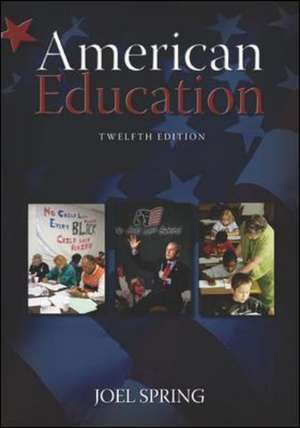Cuprins
PART 1: SCHOOL AND SOCIETY
Chapter 1: The Purposes of Public Schooling
The Problem Defining Educational Goals: Character Education
The Public Benefits of SchoolsAre Schools Always a Public Good?
History and the Goals of SchoolingThe Political Goals of Schooling
The Social Goals of SchoolingEconomic Goals
Human Capital and the Role of Business in American EducationIssues about Human Capitalism
Chapter 2: Education and Equality of Opportunity
The Common School Model
The Sorting MachineThe High-Stakes Testing Model
Education and IncomeGender, Educational Attainment, and Income
Closing the Gap Between Men's and Women's IncomesRace, Educational Attainment, and Income
Are Students Treated Equally?The Issue of Social Class
Education, Social Class, and School DistrictsEducation, Social Class, and Real Estate Brokers
Shopping for a Public SchoolSavage Inequalities
Central City SchoolsSocial Class and "At-Risk Students"
Poverty Among School-Aged ChildrenThe End of the American Dream: School Dropouts
Tracking and Ability GroupingShould Tracking and Ability Grouping Be Abolished?
Social ReproductionResistance
Parental InvolvementChapter 3: Equality of Educational Opportunity: Race, Gender, and Special Needs
The Law, Race, and Equality of Educational Opportunity
The Meaning of RaceWhat Race Am I?: Racial and Cultural Self-Identification
Race and Social ClassThe Economics of Racism
Defining RacismInstitutional Racism: Relationship Between Racial Segregation and High School Dropouts
Teaching About RacismThe Future of Desegregation
Second-Generation SegregationThe Recent Struggle for Equal Education for Women
Sexism and EducationStudents with Disabilities
Public Law 94-142: Education for All Handicapped Children Act (Individuals with Disabilities Education Act)Writing an IEP
Which Children Have Disabilities?Integrating Children with Disabilities into the Regular Classroom
Inclusion and the No Child Left Behind Act of 2001An Inclusion Success Story
The Inclusion DebatePresident George W. Bush's Commission on Excellence in Special Education
Chapter 4: Student Diversity
Is It Hispanic or Latino?
The Changing Population of U.S. SchoolsEducational Experiences of Immigrants to the United States
Immigrant LanguagesAre U.S. Teachers Prepared for Language Diversity?
Mexican American Students and U.S. SchoolsAsian American Students and U.S. Schools
Native American Students and U.S. SchoolsChapter 5: Multicultural Education
Dominated Cultures: John Ogbu
Empowerment through Multicultural Education: James Banks, Sonia Nieto, and Critical PedagogyEducating for Economic Power: Lisa Delpit
Ethnocentric EducationBilingual Education and English Language Acquisition: No Child Left Behind
English Language Acquisition Act of 2001Bicultural Education: Is This The Answer?
Globalization: Language and Cultural RightsPART 2: POWER AND CONTROL IN AMERICAN EDUCATION
Chapter 6: Local Control, Choice, Charter Schools, and Commercialism
The Education Chair
School BoardsEducational Bureaucracy
Home SchoolingSchool Choice
National Public School Choice Plan: No Child Left Behind Act of 2001Public-Private Choice Plan: The State of Ohio's Pilot Project Scholarship Program
Charter SchoolsAre Charter Schools Failing?
Examples of Three Charter SchoolsFor-Profit Schools and Charters
Edison Schools Inc.: A Tale of an Education Company in Search of ProfitThe Edison Design
Commercialism in SchoolsChapter 7: Power and Control at the State and National Levels: High-Stakes Testing, School Violence, The Reading and Math Wars, and Private Foundations
Local, State, and Federal School Revenues
Categorical Aid: The Source of Federal PowerIncreasing State Involvement in Schools
No Child Left Behind: High-Stakes Testing and Academic StandardsDoes High-Stakes Testing Work?
The Backlash to High-Stakes TestingCheating on High-Stakes Tests
The Federal Government Decides the Reading War: No Child Left BehindA Case Study: Student Violence and Federal Action
Private Foundations: The Invisible Power in EducationShould The Role of Politicians In Education Be Limited by Eliminating Compulsory-Education Laws?
Chapter 8: The Profession of Teaching
Teacher Education in a Global Economy
Disparities in Teacher Salaries and Equality of Educational OpportunityCurrent Issues in Teacher Education
Control Through Testing: National Licensing and CertificationTeacher Certification and No Child Left Behind
National Certification: The National Board for Professional Teaching StandardsTeacher Education
American Board for Certification of Teacher Excellence: Alternative Routes to TeachingThe Rewards of Teaching
Working ConditionsTeachers' Unions and Teacher Politics
Differences Between the Two UnionsA Brief History of the National Education Association (NEA)
A Brief History of the American Federation of Teachers (AFT)The NEA and the AFT Today
A Case Study: Tom Mooney, AFT Vice President and President of the Ohio Federation of TeachersShould Teachers Strike?
Chapter 9: Textbooks, Curriculum, Internet E-Learning, and Instruction
Censorship Issues
Web Scrub: A New Form of Censorship?Textbooks
Curriculum Standards and the Political Nature of KnowledgeCurriculum
John Dewey and Progressive EducationHumanistic Social Efficiency for the 21st Century
The Internet and E-LearningThe Children's Internet Protection Act of 2000
InstructionCritical Pedagogy
Chapter 10: The Courts and the Schools
Drug Testing
Students’ Free Speech RightsGays, Boy Scouts, and No Child Left Behind Act of 2001
Sexual Harassment and DiscriminationAccess to Books
SuspensionsDo School Authorities Have the Right to Paddle Children?
Compulsion and ReligionVouchers and Religious Schools
Child-Benefit TheoryCan States Regulate Private Schools?
Religion and State School RequirementsSchool Prayer, Bible Reading, and Meditation
Student PrayersSchool Prayer and the No Child Left Behind Act of 2001
Secular Humanism and the Religion of Public SchoolsEvolution and Creationism
Parents' RightsTeachers’ Rights
The Liability of TeachersTeachers’ Private Lives
The Language of the SchoolsSchool Finances
At end of each chapter: Conclusion · Suggested Readings and Works Cited in Chapter
